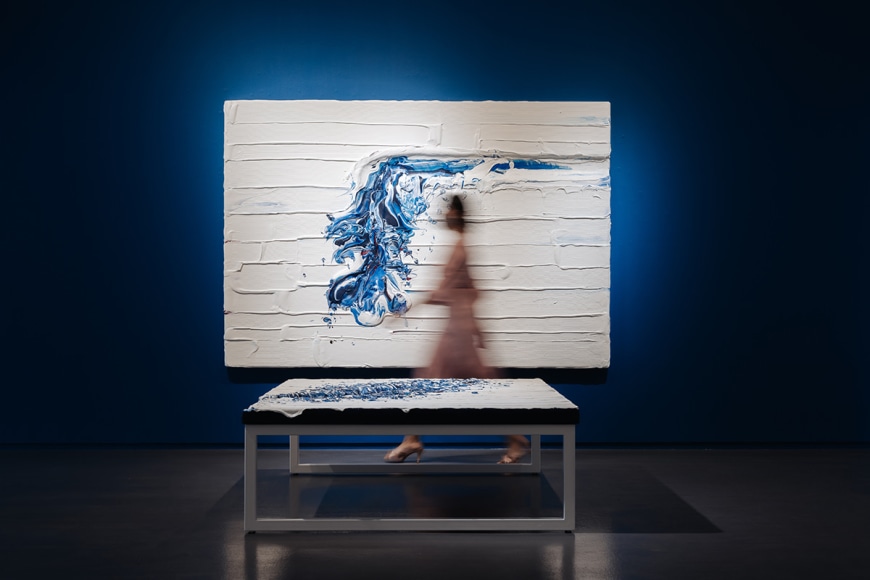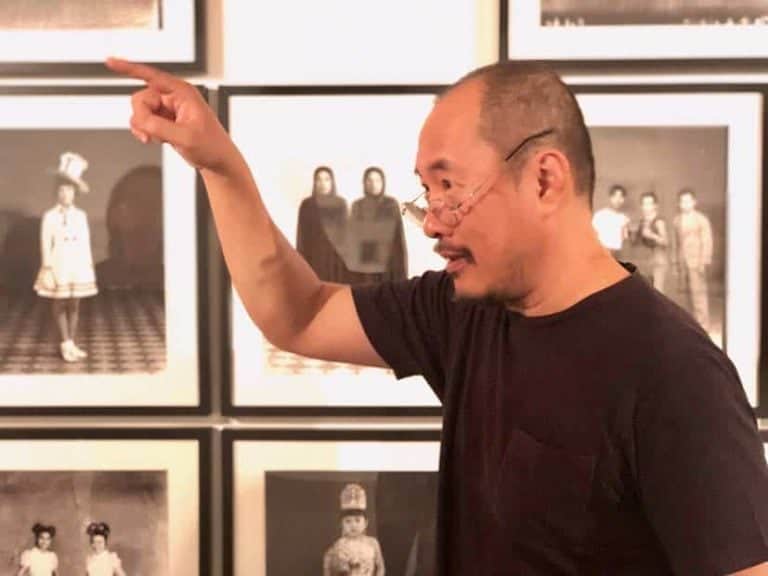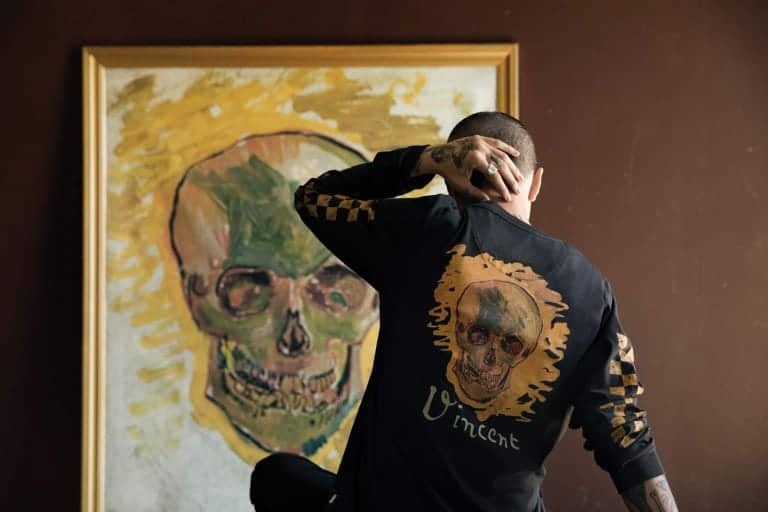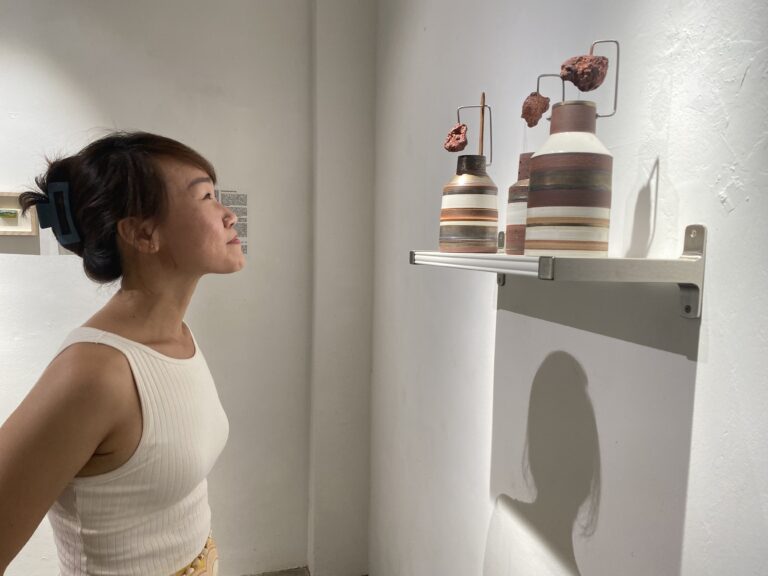When I hear the name Jane Lee, thick slabs of paint, rich textures and canvases dripping off the walls immediately come to mind. Her early large-scale painting installations like Raw Canvas (2008) and Status (2009) saw the artist literally weave threads of paint together.
Since then, a significant trait of Lee’s practice has been to push the boundaries of paint as a medium and canvas as a surface, to redefine what a painting is. You can imagine my excitement upon hearing about Lee’s new show, Where Is Painting?, presented by Sundaram Tagore Gallery at Gillman Barracks.
A sea of blue and white
As you walk through the gallery doors, a vivid ultramarine canvas, which unravels from its centre to expose different shades of blue, greets you. You cannot help but go a little closer to study its layers while visualising how each shade was peeled open. It made me wonder what it would be like to watch the artist create paintings live.
It also brings to mind Lee’s 2016 series, Wall Matters, where the wall was as crucial as paint and canvas. With it, she explored using the wall as active and negative spaces in her paintings. Where Is Painting #6 connects us to Lee’s past explorations of the wall as negative space, while building anticipation in the visitors.
To the left, a massive royal blue wall plays home to a large canvas slathered with thick, creamy layers of white. The edge of the canvas seamlessly blends with the blue of the wall, which appears to seep into the white surface.
Despite how the paint’s density and movement would typically draw one in, I cannot help but stop to admire the colours and textures from afar. Is the blue moving from the canvas to the wall, or from the wall onto the canvas?
Pressing questions
The question lingers as I move through the gallery, following the connecting ultramarine wall that spans from one end of the gallery to another. I begin to see hints of Lee’s journey with paint, everything from integrating the wall into the canvas and removing paint layers to create negative space.
These trademarks – which reflect Lee’s interest in meditation; the power of the void and emptiness; as well as aesthetic qualities of traditional Chinese landscape painting – now come together in Where Is Painting as she uses the gallery space as her canvas.
Just as I attempt to wonder about the show’s title, I encounter a wall in the middle of the gallery with the same distinct peeled-away centre. I immediately think to myself — is this a painting?
Curious presentations
On the same wall is a series of three paintings that reminds me of Joseph Kosuth’s One and Three Chairs. One of them hangs upright, while another, slightly deformed, seems about to fall off the wall. The last one rests on the floor, all scrunched up.
As I move through the gallery, the word ‘painting’ comes up as both a noun and a verb — with the works not only incorporating the physical forms of paintings but also the dynamic action of a painting stroke.
In the far corner, textural scrapes and smears appear as if hard tools were used to scratch and dig at the white walls, with debris speckling the floor. On this, Curator Tan Siuli shares:
“…The white walls of the gallery become analogous to the blank surface of a primed canvas, ready to receive the imprint of the artist’s mark-making.”
This is evident throughout the show as I find myself moving between various forms and marks. Even though these traces remain physically separate from each other, it feels as though they all belong as a single, larger artwork.
Navy canvases hang on the other side of the gallery, where the white of the walls appears to move in and through the dark blue layers. Recalling Lee’s Wall Matters series, she emphasises negative space with the crater-like hole as seen in Where Is Painting #3 and in the corners of Where Is Painting #5, which have had layers of paint removed.
Between painting and sculpting
Across the gallery, smaller, more sculptural forms that echo Lee’s Stacks (2013) and 100 Faces (2014) greet me. These deep blue-and-white pieces feature the artist’s signature aesthetic of layering and sculpting paint. The delicate blocks, with their weighted presence, are found on the floor and the wall. Each of them embodies different strokes of the artist’s hand — as layers, scrapes, and carved-out chunks.
Six cube-shaped blocks hang like tiles, recalling hints of Lee’s older works. In the corner, a quiet, short column of white and flecks of navy stands below eye level. It invites me closer, just enough to notice the glitter on its surface dancing in the light.
Beyond painting
As I move through these pieces, I encounter a quote from Lee that perfectly grounds the experience I have so far:
“Painting exists not only as an object; it can be extended into its surroundings, and even beyond.”
It reveals that I’ve been moving in and around a painting, and that painting was to be understood as both a noun and a verb. Hovering between painting, sculpture, installation, and gallery walls, the quote also addresses my wonderment as to why there are no artwork labels. Just as Tan shares,
“The context of how a painting inhabits a space, and how that space, in turn, informs the reading of her (Lee’s) work, is very important.”
This brings to mind Lee’s previous explorations with the exhibition space like in Bond II (2019), where she created strips of canvas that seem to be woven into a wall. In Where Is Painting?, the entire gallery space is a canvas, making the individual forms I encountered seem like mere elements within a larger ‘painting’.
In the way that Lee uses blue paint on the canvas and walls, it’s apparent to me that the ‘painting’ occupies the entire gallery; that the walls and the space are the canvases onto which paint is applied.
For me, Where is Painting? was very much like going on a journey with the artist. Old and new discoveries blend into one, taking the form of what’s in front of us, be it a shape, a texture, a colour, the wall or the canvas. As I begin to leave, moving through the gallery in reverse, I allow myself to experience the pieces with my newfound understanding of colour and space. In Lee’s words,
“(Paint) moves, travels, drips, solidifies, collapses, crashes, melts, reveals, exposes, dances, speaks, is inviting and delicious; tricks all the senses.”
Walking out of the gallery, I find myself having a renewed understanding of what painting can be.
____________________________________
Jane Lee – Where is Painting? runs at Sundaram Tagore Gallery until 29 October 2022. Click here to find out more.
Feature Image: Sundaram Tagore Gallery

























